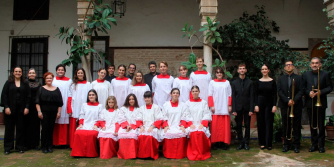Details
Espacio Turina
Laraña 4
Seville
41003
Spain
Programme
Tomas Luis de Victoria – Tenebrae Responsories
Giovanni Pierluigi da Palestrina – Sicut Cervus
Giovanni Pierluigi da Palestrina – Alma redemptoris Mater
Giovanni Pierluigi da Palestrina – Super Flumina Babylonis
Tomas Luis de Victoria – Ave Maria for 8 voices
William Byrd – Ave verum corpus
Performers
Estela Lora – Conductor
Arnau Rodon – cornett
Carmelo Sosa – alto sackbut
Ramón Peñaranda – tenor sackbut
José Arsenio Rueda – dulcian
Programme Note
Year 2025 marks the 500th birth anniversary of Giovanni Pierluigi da Palestrina, The Prince of Music (1525-1594), coinciding with the 440th anniversary of the first publication of the monumental work Officium Hebdomadae Sanctae by Tomás Luis de Victoria (Rome, 1585).
The expression Prima prattica, a term probably coined by Monteverdi around 1601, emerging as a contrast to the Seconda prattica, presupposed the observance of the compositional rule that came from the ancients and especially from Zarlino, whose authority was indisputable on this precept: the music should prevail over the text.
Palestrina's music is considered today as the apotheosis of the polyphonic vocal ideal of that era, a music that seeks to obtain a balance between melodic independence and the harmonic play of individual voices.
Tomás Luis de Victoria (1548-1611) is probably the best known of all the Iberian composers of the 16th century, and his music is the most performed throughout the world.
He was a child singer in the Ávila Cathedral where he began his musical studies; at the age of 17 he was already a student at the Collegium Germanicum in Rome, a prestigious institution founded in 1552 by Saint Ignatius of Loyola.
By the early 1580s, Victoria had become one of the most respected composers in Rome and was called to serve as personal Chapel Master to Empress Mary of Austria, daughter of Charles V, allowing him to return to Spain.
From 1587 he worked for the empress in the Convent of the Descalzas Reales in Madrid as an organist until the day of the Empress's death on August 27, 1611.
Victoria's fame is based mainly on his music composed for the Holy Week (Officium Hebdomadae Sanctae, Rome, 1585) and on his Office for the Dead (Officium Defunctorum, Madrid, 1605), both considered the most appreciated gems of their respective liturgical genres of the time, both in Spain and in the rest of Europe.
The Escolanía de Sevilla (f. 2017), is a choir of forty children and youths between the ages from 8 to 27, mostly music students at local conservatories. The group is dedicated to studying and performing SATB repertoires from the Renaissance and Baroque to the present, with the aim of training future singers and complementing the students' musical studies with a solid basis of vocal education.

 Your events at Classical Events
Your events at Classical Events

